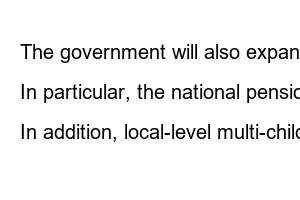다자녀 혜택As one of the measures to address the low birth rate, the government is promoting lowering the standard for multi-child benefits to 2 children per 3 children, which will substantially reduce the burden of raising children in multi-child households. In addition, education expenses for elementary, middle, and high schools will be improved to support two-child households or the first child first, and support for raising and education for families with multiple children will be expanded, including reforming the national pension maternity credit.
The Ministry of Education announced the ‘Direction of Promotion and Improvement of Multi-Children Household Support Policy’ at the 7th Social Relations Ministerial Meeting held at the Seoul Government Complex on the 16th, presided over by Deputy Prime Minister and Minister of Education Lee Joo-ho.
This plan is being reviewed and promoted at the pan-government level with the participation of the central government and local governments in accordance with the ‘Policy Tasks and Directions of the Low Birth Rate and Aging Society of the Yoon Seok-yeol Government’ announced by the Low Birth Rate and Aging Society Committee on March 28.
According to the plan announced by the Ministry of Education on this day, the standard for benefits for multiple children will be relaxed from 3 children to 2 children.
The government plans to relax the special treatment standard for public housing with multiple children to two children by the end of this year and also consider relaxing the special treatment standard for private housing. Standards for appropriate supply area considering the number of household members will also be established so that households with many children can live in public rental housing with a large area.
It was decided to revise the Local Tax Special Tax Restriction Act in line with the sunset deadline next year so that the automobile acquisition tax exemption and reduction benefits, which were previously only provided to households with three children, can also be provided to households with two children.
The standards for multiple children at cultural facilities are also simplified. National cultural facilities such as the National Theater and art museums, which used to provide discounts on usage fees based on multi-child preferential cards, will also unify the multi-child benefit standard to two children. In addition to the multi-child preferential card, family relationship certificates will also be accepted as supporting documents. It was also decided to review the operation of a fast track system that would allow infants and children accompanying them to enter the exhibition first.
In addition, by revising the ordinances of Busan Metropolitan City and Daegu Metropolitan City, the multiple-child standard for all metropolitan local governments will be unified to 2 children by next year. Basic local government business units also decided to gradually relax the criteria for benefits for multiple children.
The government will also expand support for raising and educating families with multiple children.
The plan is to reduce the burden of raising children on households with multiple children by including households with multiple children in the support for elementary child care classes and providing additional discounts on child care service expenses depending on the number of children.
In particular, the national pension maternity credit will also be reformed. Previously, the subscription period was included starting from two children, and the additional inclusion period per child was increased for three or more children. However, in the future, it was decided to consider expanding the maternity credit when establishing the 5th National Pension Comprehensive Operation Plan to reflect the current low birth rate situation.
Support for elementary, middle and high school education expenses will also be increased. In the case of elementary, middle, and high school education expenses, which were mainly supported starting with the third child of households with three or more children, the support is being improved to provide support starting with the first child or households with two children.
In addition, local-level multi-child support policies will be strengthened, such as expanding multi-child support items considering the actual needs of residents.

